 |
| Category:WW1 |

|
|
|
|
|
|
42nd
Battalion arrive at Larkhill Camp on the Salisbury Plain
|
| Research and photographs
by Richard Crompton, Oxfordshire UK |
| Today
Larkhill Camp is a School of Artillery for the British army.
The coloured
photographs, of the modern camp, were taken the day before Gulf War II
was declared and when the Corporal of the Guard politely said that
‘Today isn’t a good day for taking photographs, Sir.’
Larkhill Camp
began on 12 August 1914, and completed in early 1915, was designated
as the School of Instruction for Royal Horse and Field Artillery
(Larkhill).
|
 |
| The
typical wooden and tin-hut buildings, some standing on two to three
feet brick pillars, were suitable for all year use and for the
continual coming and goings of a large number of troops. |
 |
|
Construction
of the hutted camp in 1914. Source:
NDG James
|
| After
the war, an observer described the camp as a collection of ‘tin huts
– even the Church and the cinema were corrugated iron’. |
 |
|
The
partly completed camp.
Source: Wiltshire
Photographic Archives
|
| The
new roads, constructed by the Royal Engineers from the natural chalk
of Salisbury Plain, extending from the camp to the training grounds,
proved sticky when wet and covered in clouds of white dust when dry. |
 |
|
During
the winter of 1916 the chalk surface turned to sloppy mud.
Source:
NDG James
|
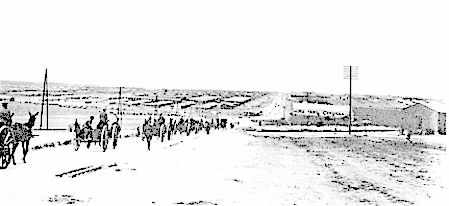 |
Transport
returning to Larkhill, from the training grounds, along the chalky
Packway, during the dry, dusty
summer months.
Source:
NDG James
|
|
A
Military Light Railway connected Larkhill to the London and
South-western Railway spur, at Amesbury Station, crossed the Packway
and terminated at Rolleston Camp, with a spur to the site of the
original Fargo ammunition dump. The
course of the light railway’s permanent way, though pulled up in
1935, can be traced by a line of apple trees that, it is said, have
grown from the seeds of apples thrown out by troops on passing trains.
|
 |
After
the War Sergeant’s Empire Stores and Restaurant came under new
management.
Source:
Wiltshire Photographic
Archives
|
|
Thirty
four individual infantry
training camps, of a size suitable for a battalion at war strength, were
added, and experienced by ‘units of practically every arm of the
British Army.’

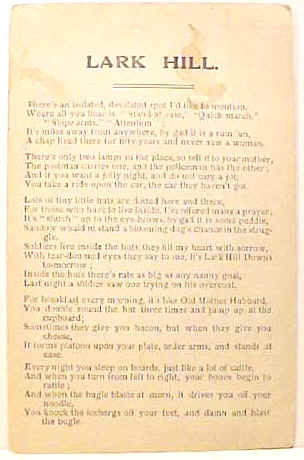 |
-
The
verse, entitled ‘Larkhill Camp’, emphases the importance of
infantry training, and highlights the difficulties
|
LARKHILL CAMP
-
There’s
an isolated desolate spot that I’d like to mention
-
Where
all you hear is ‘Stand at ease’, ‘Slope arms’, ‘Quick
march’, ‘Attention’
-
‘Slope
arms’, ‘Fix bayonets’, then ‘Present’, they don’t half
put you through it
-
And
as you stagger to your hut, the Sergeant shouts ‘Jump to it’.
-
It's
miles away from anywhere, by gad it's hard to have fun,
-
A
bloke lived there for 50 years and never saw a woman.
-
There's
only 2 lamps in the place, so tell it to your Mother
-
The
postman always carries one, the policeman has the other
-
And
if you want a jolly night and you don't care a jot
-
Just
take a ride inside the car, the car they haven't got.
-
Lots
and lots of tiny huts are dotted everywhere
-
For
those who have to live in them, let's offer up a prayer
-
The
soldiers live inside the huts, it fills my heart with sorrow
-
Inside
the huts there's great big rats, as big as nanny goats
-
Just
last night a soldier saw one, trying on his greatcoat.
-
For
breakfast every morning it's like Old Mother Hubbard
-
You
double round the hat three times and jump up at the cupboard.
-
Sometimes
they give you bacon, sometimes they give you cheese
-
It
forms platoons upon your plate, Orders Arms and Stands at Ease.
-
Every
night you sleep on boards, just like a lot of cattle
-
and
when you turn from left to right, your bones begin to rattle.
-
and
when the bugle blasts at morn it drives you off your noodle
- you
knock the icebergs off your feet and damn and blast the bugle
|
 |
|
In
1916, the AIF decided to form Australian training battalions in England
from which reinforcements could be posted to Australian Divisions in
France. As well, Battalions that were
already formed, such as the 42nd, did their acclimatization and final
training on the Salisbury Plain. Camps were established at
Larkhill, Rolleston, (See map)
Perham Downs, Parkhouse and Tidworth.
However, Larkhill seems to have been unpopular with the
Australians. On 3rd
September 1916, W.J Sinney wrote, in an unpublished letter:
‘It
has been raining like fun here and things about Larkhill are pretty
sloppy. It’s a rotten
place when it rains and a jolly sight worse if it keeps fine for any
length of time. The dust is
that fine that it will get in anywhere; do what you will you can’t get
away from it.’
During
July 1916, units of the 3rd Division began to arrive from Australia and
assembled at Larkhill, where they remained, in training, until the
Division moved to France at the end of the year.
And so the 42nd arrived, all the way from sunny Queensland, by
way of Egypt, at Amesbury Station.
|
 |
|
Troop
movements at Amesbury station.
|
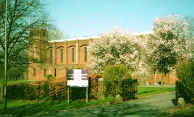 |
They marched
through Amesbury town (See
above) on their way to their
billets in Camp 11, (see right)
in huts behind the then corrugated iron Garrison Church.
(See left) From
there the Battalion ventured along the Packway, on to the vastness of
Salisbury Plain and its rifle ranges, for its final training.
|
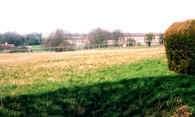 |
| The
modern Garrison Church at Larkhill.
Behind this is the site of the 42nd’s
Camp |
The
ground once covered by the huts of Camp 11, taken from the corner of
the Garrison Church grounds. |
|
Then
‘Saturday, November 25th 1916 witnessed the departure from Salisbury Plain
of the 42nd Battalion. After
chafing for months under the routine of drill and exercise, the Battalion at
last emerged as a smart, well equipped, highly trained fighting unit, with
every man fit and eager to get to grips with the enemy.
Its
strength was 33 officers and 994 other ranks.
Reveille was sounded at 4.30am.
It was a cold bleak morning on which we partook of our last breakfast
at Number 11 Camp, Larkhill. After
the meal, a period of tremendous hustle and bustle ensued.
There
were strapping and unstrapping of equipment, the packing of packs, to say
nothing of the unceasing struggles to get all personal possessions, gear,
ammunition, rations, blankets and utensils securely
buckled to our body. These
weighed approximately 100lbs, exclusive of rifles.
At
length we fell in for final inspection, then off we went on the four-mile
journey to Amesbury railway station, gaily marching to the strains of the
‘Colonel
Bogie March’ played by the Battalion Band.
The
Battalion left Amesbury on three trains, which arrived at Southampton at
11am, noon and 2pm’ (Brahms) on its way to play its part in the mud of the
Western Front and the chalk of Picardy and Artois.
-
Sources:
-
Brahms V,
1938, The Spirit of the Forty
Second, Smith and Paterson, Brisbane
-
James, NDG,
1983, Gunners at Larkhill –
a history of the Royal School of Artillery, Griesham Books,
Salisbury, 0946095086
-
James, NDG,
1987, Plain Soldiering – a
history of the armed forces on Salisbury Plain, Hobnob,
Salisbury, 094618039
-
Wiltshire
County Council Photographic Archives, Wiltshire Libraries and
Heritage, Trowbridge, Wiltshire
-
Notes
-
The Military
Light Railway started at GR 162424, crossed the Packway at GR
113445, terminated at GR 103449 and at GR 103446, the original Fargo
ammunition dump.
-
The name
Packway, for the main road through Larkhill Camp, may have derived
from an ancient packhorses trading route, or from the army packs
carried to the training grounds.
|
|
THE KING'S MESSAGE |
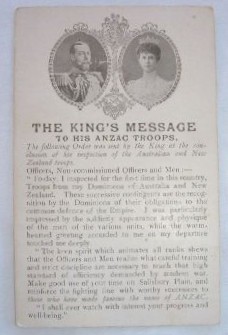 |
|
THE KING'S MESSAGE |
|
TO HIS ANZAC
TROOPS |
The following Order was
sent by the King at the completion of his inspection of the Australian and
New Zealand troops.
Officers, Non-commissioned
Officers and Men:-
"Today, I inspected
for the first time in this country, Troops from my Dominions of Australia
and New Zealand. These successive contingents are the recognition by the
Dominions of their obligations to the common defence of the
Empire".
"I was particularly
impressed by the soldierly appearance and physique of the men of the
various units, while the warm-hearted greeting acceded to me on my
departure touched me deeply". |
| "The
keen spirit which animates all ranks shows that Officers and Men realize
what careful training and strict discipline are necessary to reach that
high standard of efficiency demanded by modern war. Make good use of you
time on Salisbury Plain and reinforce the fighting line with worthy
successors to those who have made famous the name of A.N.Z.A.C."
"I shall ever watch with interest
your progress and well-being". |
|